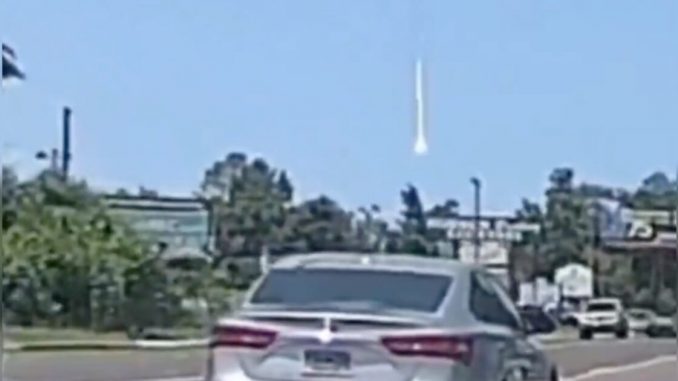
A fireball captured on a dashcam in South Carolina
| Published June 27, 2025
There have been hundreds of reports of sightings of a “fireball” in the skies over the southern US – it may have been a meteor breaking up as it falls through Earth’s atmosphere
A rare and dramatic daytime fireball dazzled and rattled the southeastern U.S. sky on June 26, around 12:24–12:30 p.m. EDT, with hundreds of reports across Georgia, Alabama, North/South Carolina, Florida, Tennessee—and even captured on dashcam and satellite sensors.
🌠 What Was It?
-
Meteor or space debris?
Most likely a natural meteoroid—a fragment from an asteroid or comet—that entered Earth’s atmosphere and became incandescent. However, authorities considered the possibility of evolved space junk. -
Exceptionally bright — a fireball or bolide.
Shadows and daylight-streaked light indicated a magnitude around –14, categorizing it as a bolide (a super‑bright meteor).
📡 Sensor & Radar Signatures
-
GOES satellites detected lightning-like flashes via their Geostationary Lightning Mapper—unusual in clear skies—confirming an intense atmospheric event.
-
Doppler radar later identified debris signatures consistent with falling meteorites.
🌍 Path, Power & Breakup
-
Entered over Oxford, Georgia, descended southwest at about 30,000 mph, beginning roughly 48 miles up, breaking apart near 27 miles altitude.
-
NASA estimated the energy release at about 20 tons of TNT, producing a shock wave—heard and felt as a sonic boom—across hundreds of miles.
💥 On-the-Ground Impact
-
Sonic boom, not seismic activity:
Residents reported earthquake-like tremors—but no quake was recorded; it was caused by the supersonic blast . -
Damage to property:
In Henry County (McDonough), GA, a homeowner reported a “rock” crashing through their roof and ceiling, cracking laminate flooring—no injuries yet confirmed. -
Potential meteorites found:
Some fragments are under investigation, possibly recovered near Blacksville, GA, and areas along the Georgia–South Carolina border.
LOOK:
Here’s the hole an apparent meteorite made in one Henry County home, and what landed on floor. We’re covering this story live on Channel 2. pic.twitter.com/eBc6GtrvEk
— Brad Nitz (@BradNitzWSB) June 26, 2025
Here was a nice shot of the fireball:
☄️ Amazing photo of the fireball from Macon, Georgia. Taken by Josh Grant, via our content partner WMAZ. https://t.co/chrVRXGtfH pic.twitter.com/Afh78Iv1I8
— Brad Panovich (@wxbrad) June 26, 2025
 Implications
Implications
🔬 1. Scientific Discovery & Research
-
Meteorite Recovery: If fragments are confirmed and retrieved, they could offer clues about the solar system’s origins—many meteorites are older than Earth itself.
-
Trajectory Analysis: Scientists can reconstruct its orbit, potentially identifying its origin (asteroidal belt or comet trail), helping us better understand near-Earth objects (NEOs).
-
Data for Planetary Defense: Events like this improve tracking systems, helping governments and space agencies prepare for potentially hazardous asteroids.
🧯 2. Public Safety & Emergency Awareness
-
Impact Risk Realization: A meteorite damaging a home (as seen in Georgia) reminds the public and officials that Earth is constantly exposed to extraterrestrial debris.
-
Preparedness Planning: Local governments may begin considering how to respond to future atmospheric entries—especially over populated areas.
🌍 3. Environmental & Atmospheric Effects
-
Airburst Events: High-altitude explosions like this one, while usually harmless, can release energy equivalent to small conventional bombs. These need ongoing monitoring.
-
Climate Studies: Massive airbursts historically have altered atmospheric conditions (e.g., Tunguska 1908). While this fireball was far smaller, it adds to the climate-impact data bank.
📺 4. Cultural & Educational Impact
-
Inspires STEM Interest: Visible daytime meteors spark public curiosity—great for schools, museums, and science outreach programs.
-
Media and Myth: These events often fuel viral theories (aliens, conspiracies) but can be redirected to boost scientific literacy.
🌌 5. Reaffirming Earth’s Cosmic Vulnerability
-
Despite advanced tech, large space rocks still enter Earth’s atmosphere with little or no warning—this underscores the importance of global cooperation in space monitoring efforts like NASA’s NEO Surveyor and ESA’s Hera mission.
💬 Overall Takeaway:
The rare and powerful daytime fireball that streaked across the southeastern United States in June 2025 was more than just a fleeting spectacle—it was a vivid reminder of Earth’s ongoing exposure to space debris and the dynamic nature of our skies. While no serious injuries were reported, the event shook homes, rattled windows, and ignited both public curiosity and scientific investigation.
From potential meteorite recovery and orbital analysis to broader discussions about planetary defense and emergency readiness, this event holds lasting value beyond its brief flash in the sky. It reinforces the need for continued investment in space observation, scientific outreach, and public education—ensuring we stay alert, informed, and inspired by the cosmos above.




